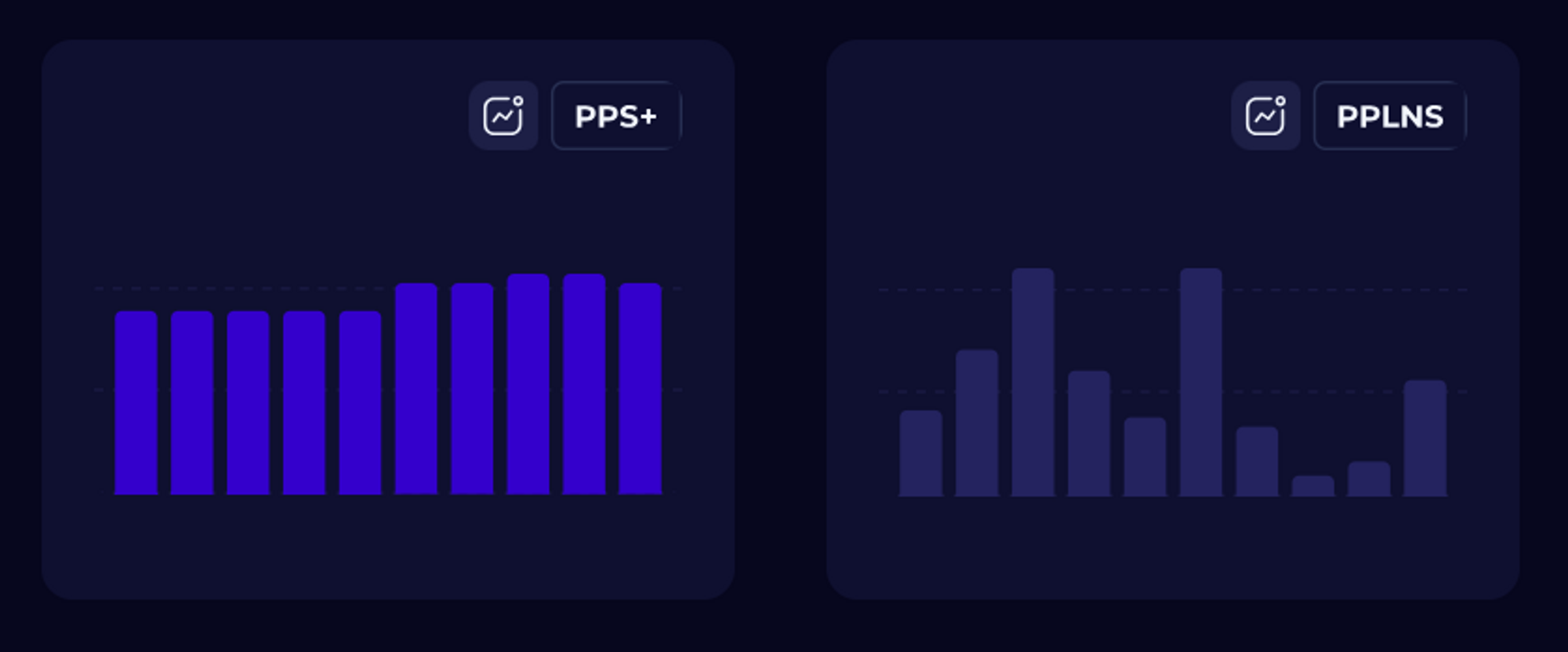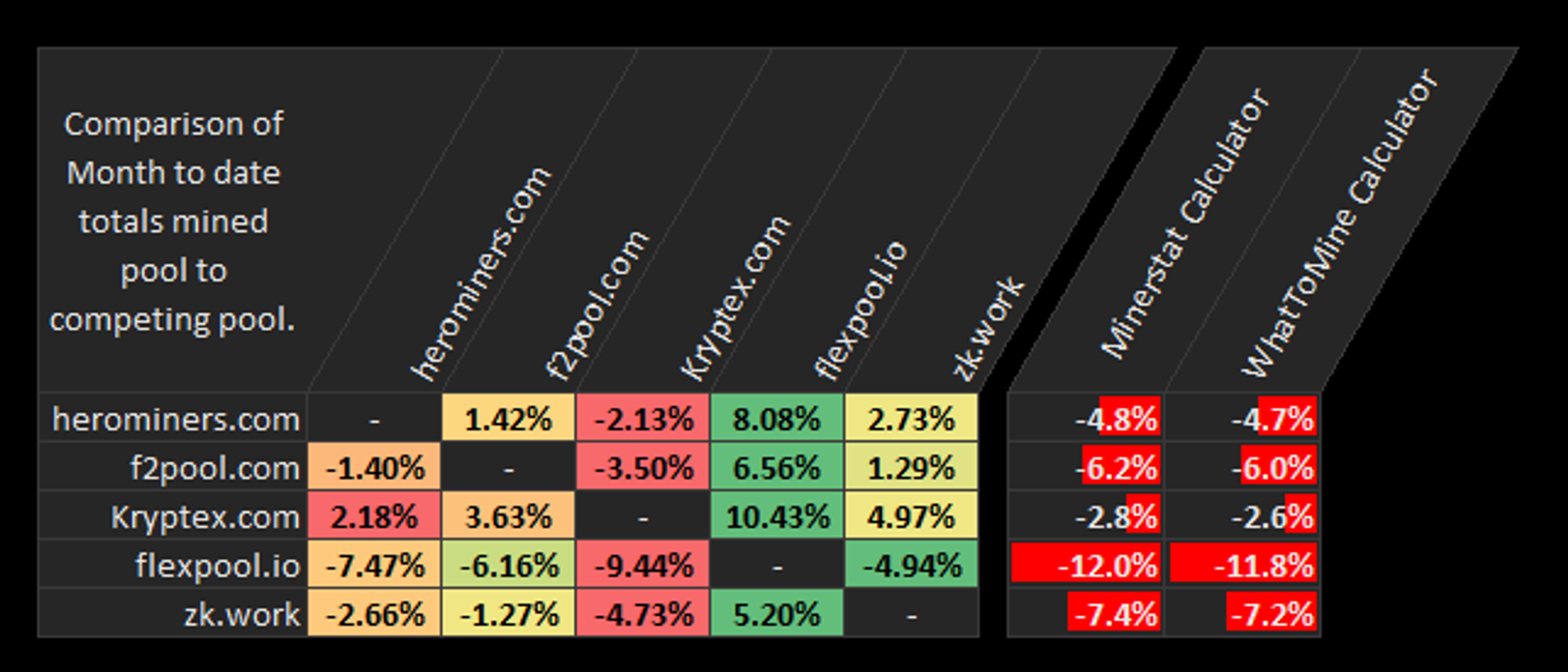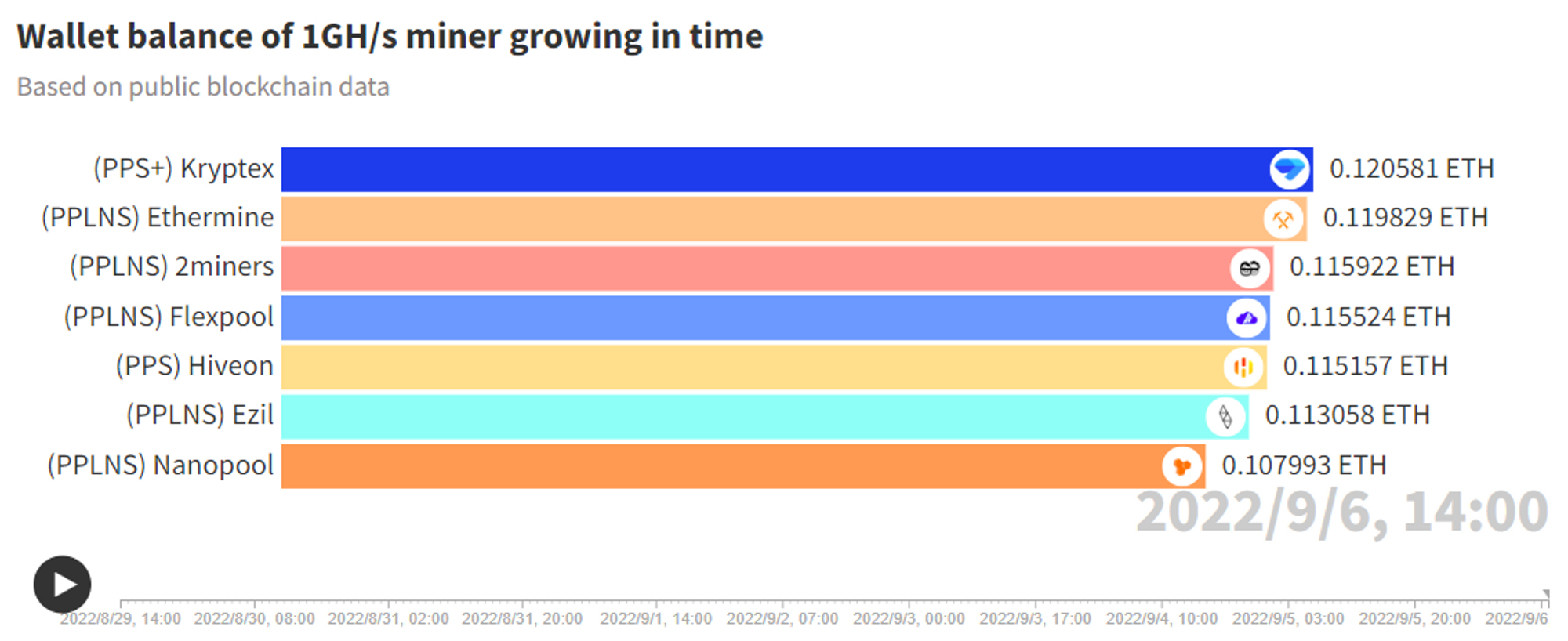PPS+ vs PPLNS
02/08/2023
Mining pools that use the PPS+ payout system, (Pay Per Share), offer more advantages than pools that use the PPLNS payout system, (Pay Per Last N Shares).
PPS+ is undoubtedly the most beneficial payout system for miners as it provides a clear understanding of earnings, regardless of whether the pool finds blocks.
In this article, we will explore:
- The differences between PPS+ and PPLNS pools through a straightforward example.
- The risks miners face when participating in PPLNS pools.
- A comparison between PPS+ and PPLNS pools.
- A comparison of pools held by independent miners.
- The objective reasons why PPS+ pools stand out as the superior choice for miners.
PPS+ vs PPLNS: A Simple Explanation
Using a straightforward example, let's delve into the distinction between PPS+ and PPLNS mining pools.
Imagine you're at a canteen for lunch, and there are two pizza dispensers available:
- The first machine guarantees half a pizza for your lunch every day.
- The second machine provides a whole pizza but with a 50% chance.
Let's see how your lunch experience plays out over different periods.
- If you eat at the canteen for two days, the first machine ensures you get one pizza. The second machine remains a gamble. It's like a lottery; you could get two pizzas, one pizza, or nothing!
- Suppose you eat at the canteen for 30 consecutive days. The first machine consistently gives you 15 whole pizzas. On the other hand, the second machine will likely provide you with around 15 pizzas, but it's not guaranteed. It all depends on luck. The outcome will probably be close to 15 pizzas.
Would you want to eat pizza for such an extended period, knowing that you might end up with nothing for lunch on some days, even if the next day gives you a whole pizza? And today, you still go hungry.
It's easy to figure out that the first machine represents PPS+, and the second is PPLNS.
With PPS+, you can join, experiment, change algorithms, or leave anytime without affecting your earnings! Each share you contribute will be rewarded.
On the other hand, with PPLNS, you need to mine continuously for a long time to achieve a payout comparable to PPS+ unless you get lucky.
That's the fundamental difference between these two payment systems.
Occasionally, if pools using PPLNS find blocks more frequently, the miner's reward might surpass that of PPS+. However, this is not a consistent occurrence known as "pool luck".
Reliability and Stability with PPS+
In PPS+ pools, every miner is assured of a reward for each correct share sent, irrespective of the pool's luck.
On the other hand, in PPLNS pools, payouts are determined by the number of shares sent before finding a block within a specific time interval. Additionally, the reward is divided among all participants based on the number of shares they contributed before finding the block. This setup often leads to significant fluctuations in miners' income, particularly when the pool discovers blocks with uneven frequency or when miners fail to submit the required number of shares in time.
PPS+ payout system offers reliability and predictability in miners' income. You receive payment for each share, regardless of whether the pool finds blocks. You can avoid variability with the PPS+, as miners are guaranteed a fixed payout for every correct share they submit.
PPS+ Consistent Luck at 100%
As mentioned, PPS+ ensures stable and reliable payouts, providing miners with precisely what they deserve. There are no notions of "favorable luck" or "unfortunate luck." Miners receive payment for every correct share they submit, and transparency is paramount with no hidden fees.
In a scenario where pool experiences exceptional luck and discovers more blocks than expected, miners reap more fantastic rewards!
Example of a PPS+ pool with favorable luck:

On the flip side, if the pool encounters less luck and obtains fewer blocks, the rewards for miners will be lower than anticipated.
Example of a PPLNS pool with unfortunate luck:

With PPLNS, you receive the income when your pool gets lucky and finds a block. If there are no blocks or if they are found with irregular frequency, your income will fluctuate dramatically like a roller coaster ride!
Here are income charts for pools. On the left, we have a pool with a PPS+ payout system, and on the right, a PPLNS pool.

Reward Calculation in PPS+
In contrast to PPLNS, where the reward distribution depends on the number of shares found before discovering a block, PPS+ uses a straightforward and transparent method of calculating rewards. This means that PPLNS pools often ignores miners' efforts. If you disconnect before a block is found or encounter bad luck, you won't be rewarded for your mining efforts.
On the other hand, the PPS+ pool offers miners a clear and easy-to-understand reward calculation method. Miners can easily estimate their potential earnings by knowing the share reward and hashrate. This convenience allows them to use mining calculators to approximate their income.
The PPS+ pool applies a simple formula to calculate the reward:
pps_share_cost = block_reward * share_diff / net_diff
With PPS+ pools, there's no need to wait for extended periods (like 3-5-7 days) to verify the accuracy of charges.
You can check your earnings on a PPS+ pool after just 1 hour of mining using any calculator - Whattomine, Minerstat or any other. All mining calculators are designed to work on the PPS+ payout system.
PPS+ Security Measures
One of the significant advantages of PPS+ pools is their protection for their miners against DDOS attacks aimed at manipulating the block finding frequency.
For instance, imagine attackers attempting to alter the frequency of block discovery. They may do this to hinder a competitor pool from finding blocks or to intercept blocks from a rival pool earlier. In such scenarios, miners on PPLNS pools under attack would suffer losses due to the changes in block frequency.
The frequency of block discovery is crucial for PPLNS pools because miners are only compensated for the shares they submit before a block is found. If the block finding frequency is modified, another pool might find a block earlier, and the miners in the affected PPLNS pool wouldn't get paid.
On the other hand, miners in PPS+ pools are protected from such attacks. In PPS+ pools, miners receive payment for each share they contribute, and the pool assumes all the risks and losses while continuing to pay the miners precisely as per the established formula.
PPS+ pools safeguard their miners from losses in case of DDOS attacks aiming to manipulate the block frequency.
PPS+ Cares for Miners
In the PPS+ pool, miners can use any equipment, regardless of its computational power.
Miners with weaker graphics cards or limited computing capacity may face extended periods without finding blocks in PPLNS pools, resulting in unstable income. But why does this happen?
For instance, let's consider a scenario where you mine with just one graphics card, and the pool share difficulty is tailored for high hashrates (pools often set high share difficulty for their benefit). This setup might not make any profit.
With high share difficulty on the pool, your graphics card can't find shares within 5-20 minutes. For a PPLNS pool, this can be problematic since your graphics card might need more time to find the required number of shares before the pool discovers a block, ultimately leading to no mining reward for you.
PPS+, on the other hand, compensates for each share regardless of whether a block is found. It doesn't matter when or how quickly you find a share. With PPS+, you will receive 100% payment for your work, regardless of your equipment's power and the pool's share difficulty.
The PPS+ pool suits novice miners with just one graphics card and professional miners with an ASIC hangar.
Comparative Testing of PPS+ and PPLNS
The ongoing debate regarding which payout system proves more profitable for miners remains a topic of discussion. Each pool stands independently, relying on its infrastructure and transparent data.
A user with the nickname Strongbob conducted parallel testing in May, 2023 using the IRON FISH coin to gain practical insights into which payout system brings higher profits. The test involved mining with identically configured equipment on the TOP-5 pools, each using a different payout system.

After a month of parallel mining, the results showed that the PPS+ Kryptex Pool paid miners approximately 2% more than the other pools. Keep in mind that other PPLNS pools had even lower fees, and on certain days, PPLNS paid out more due to the pool's luck.
Interestingly, even on "lucky" days, PPLNS pools with significant hashrates and low fees still didn't surpass the PPS+ pool in payouts.

You can access the complete test process and its results via the source on the official IRON FISH Discord.
Reliability through Data: Emphasizing Statistics over Randomness!
To ensure consistency and steer clear of randomness, we continuously monitor the profitability of our PPS+ pool and compare its income with other PPLNS pools.
In 2022, we conducted an extensive pool comparison for the ETH coin (considered the most profitable before POS).
The findings revealed that, over the long term, PPS+ consistently provided higher rewards to its miners compared to PPLNS pools. We carried out this measurement for an entire month and cross-checked the data thoroughly using the public blockchain.

For a comprehensive overview of the test results, you can explore the details here: https://pool.kryptex.com/en/compare-mining-pools.
The Rarity of PPS+ Pools
Have you noticed that PPS+ pools are less common than PPLNS or other pools? Maintaining a PPS+ pool is more challenging than running a PPLNS pool.
A PPLNS pool distributes rewards to miners based on the blocks found but consistently deducts a fee from each miner's earnings. It doesn't matter whether the pool had good luck, found many blocks, or faced lower luck resulting in reduced rewards. The PPLNS pool operates without taking risks and consistently generates profits, while potential losses or reduced payouts fall upon the miners.
On the other hand, a PPS+ pool ensures that miners receive precisely the amount calculated, regardless of the number of blocks the pool finds. PPS+ pools shoulder the risks of facing low luck by continuing to pay miners with clarity and consistency. Sometimes, PPS+ pools may have a slightly higher fee.
Kryptex Pool adopts a fee similar to PPLNS pools and only increases fees to ensure fair hashrate distribution across the network.
Even if a PPS+ pool doesn't find blocks, it pays miners as per the calculated amount. PPS+ pools take on all the risks, while PPLNS pools pass those risks onto the miners.
PPS+ vs SOLO Mining
Some miners opt for SOLO mining.
SOLO mining entails receiving the full reward for a found block without sharing it with other pool members. It might sound enticing and profitable but it comes with even more risks.
- Low Probability of Finding a Block: The likelihood of finding a block in SOLO mining is much lower than when mining on the pool. Miners might mine for days or weeks without profit until they finally discover the desired block.
- High Difficulty Level: Finding a block on your own requires colossal computing power from your equipment! The higher the overall network difficulty of the coin you are mining, the more computing power is necessary to find a block successfully.
On the PPS+ pool, you can mine with just one graphics card and receive a reward for each share you contribute. In contrast, SOLO mining demands an entire hangar of mining rigs or powerful ASICs to have a chance at finding a block. Yet, even with such hardware, a stable discovery of blocks is not guaranteed.
Trust but Verify!
Refrain from mindlessly believing everything you read on the Internet — take the time to verify it yourself! Your income is under your control!
Be proactive and check the pools independently, conduct tests, and compare them with a reliable calculator. The more frequently you verify the accuracy of accruals in pools, the better it is for your earnings.
If you are mining on the Kryptex Pool and notice any discrepancies with the calculator, don't hesitate to contact us! We will investigate and address any inconsistencies.
Are you mining on another pool with PPLNS? If the pool is not fulfilling its promises and attributing it to "poor luck," there might be a possibility that hidden fees are involved!
Now might be the perfect time to try something entirely different — try Kryptex PPS+ Pool!
Final Thoughts
- At Kryptex PPS+ Pool, you are guaranteed 100% luck at all times.
- With Kryptex PPS+ Pool, you can expect a completely transparent and predictable income, easily verifiable with a mining calculator after just one hour of mining.
- PPS+ pools protect miners as the pool assumes all risks.
- It's essential to regularly monitor your income on different pools using a mining calculator.
- Are you mining with PPLNS? Give PPS+ a try — it might be what you've been searching for!
- PPS+ consistently offers higher payouts even if the pool fee appears higher.
We have identified at least 18 reasons why PPS+ Kryptex Pools are superior.
Check it out and see for yourself: PPS+ Kryptex Pool is the best choice!